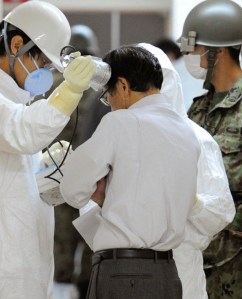
A man is tested for radiation in Fukushima
(UPDATED) Japanese officials announced on Tuesday morning that they were planning to raise the event level at the Fukushima Daiichi nuclear power plant from 5 to the maximum level of 7, the highest on the international scale for nuclear incidents and the same level assigned to the 1986 disaster at Chernobyl in the Ukraine.
The decision was made after Japan’s nuclear safety body determined that at one point after the March 11 earthquake, the plant was releasing 10,000 terabecquerels of iodine-131 for several hours; level 7 accidents are defined as releasing tens of thousands of terabecquerels. “The INES [International Nuclear and Radiological Event Scale] rating itself is not an indicator of a daily phenomena but the assessment after careful consideration and calculation on the event that happened in the past,” Ken Morita of Japan’s Nuclear and Industrial Safety Agency (NISA) tells TIME.
NISA also noted that the amount of radioactive material being released at Fukushima today is less than 1 terabecquerel. The agency said that to date, Fukushima has released only about 10% of the total radiation released 25 years ago at Chernobyl, or about 1.8 million terabecquerels. About 30 people, mostly workers, died in the immediate aftermath of Chernobyl, though the U.N. has estimated that the long-term death toll due to exposure could eventually be as high as 4,000.
(More on TIME.com: See the top 10 environmental disasters.)
INES, designed in 1989 by the International Atomic Energy Agency (IAEA) and the Nuclear Energy Agency of the Organisation for Economic Co-operation and Development, ranges from 1 (anomaly) to 7 (major accident). The scale is intended to help easily communicate with the public to indicate the seriousness of a nuclear event. Chernobyl is the only other event to have been given a 7, an accident classified as having a major radioactive release with widespread impact on the environment and public health. According to INES, “Such a release would result in the possibility of acute health effects; delayed health effects over a wide area, possibly involving more than one country; long-term environmental consequences.” (Read the IAEA’s glossary of short- to long-term health effects of radiation exposure here.)
Besides Chernobyl, the only other event that has come close to a 7 was a 1957 accident at a fuel-processing plant (where spent nuclear fuel is recycled into new fuel) in Russia, in which an off-site release of radiation prompted preventive evacuations. The Three Mile Island accident in the U.S. in 1978, in which a reactor core was severely damaged, but the off-site release of radioactivity was limited, was classified as a 5. Almost all reported events at nuclear facilities are a level 3 or lower, according to INES.
Tuesday’s announcement comes on the back of a minor fire spotted by workers outside Fukushima’s Reactor 4 on Tuesday morning, shortly after the second of three major aftershocks hit the beleaguered northeast in a span of 24 hours. Three people in Iwaki died in landslides triggered by the 7.1-magnitude aftershock on Monday night. The government also expanded the exclusion zone around Fukushima on Monday to include several towns within a 19-mile (30 km) radius where residents had been told they could remain at home but were recommended to stay indoors. The towns added to the mandatory evacuation zone were found to have high levels of radiation.
Meanwhile, Greenpeace said that in a survey conducted in Fukushima last week, its team of experts found radiation levels 75 times higher than the government recommendation in 11 samples of vegetables from gardens and small farms. The environmental group also announced that it found radiation levels equivalent to an annual exposure of 5 millisieverts — the evacuation threshold for Chernobyl — at a playground in Fukushima City, pop. 300,000. Greenpeace is urging the government to delay the start of the school year.
Though raising Fukushima’s level to 7 may not herald any immediate worsening of events, it is sure to add to many residents’ growing concern — and feeling of helplessness — over what could happen at dozens of other nuclear reactors spread across this seismic archipelago. On Sunday, more than 17,000 people protested at two demonstrations in Tokyo against nuclear power. It was the first time that Yohei Nakamura, 45, had ever been to a protest. “For a long time, I’ve been suspicious of nuclear power, but now I realize it’s a serious problem,” he said amid the crowds carrying placards and shouting slogans. He said anti-nuclear demonstrations were undercovered in the Japanese press because of the influence of the Tokyo Electric Power Co., which owns Fukushima. “TEPCO is one of the most powerful companies in Japan,” Nakamura said. “They use a tremendous amount of money for advertising. If the mass media shows anti-nuclear-power activities like demonstrations, they risk losing TEPCO as an advertiser.”
— With reporting by Lucy Birmingham / Tokyo


